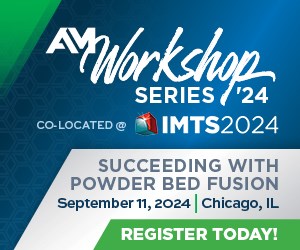Piab’s Small Vacuum Conveyor Safely Handles Metal Powders
Typical applications include metal powder transfer to or from a hopper or a sieve, feeding a 3D printer or recirculating material from the overflow bin.
The Piab piFLOWam can cleanly and safely convey metal powders for additive manufacturing.Photo Credit: Piab
Piab’s piFLOWam is a small vacuum conveyor developed specifically for additive manufacturing (AM) production to safely handle materials, including filling, conveying and reclaiming metal powders.
The small, compact design features Piab’s efficient COAX vacuum technology as well as a butterfly valve. The butterfly valve is not sensitive to pressure fluctuations and is able to keep a material batch inside without the pump being mounted. It has a standard TC-coupling for easy integration and is designed to take up minimal space.
Valves 101: An Overview of Butterfly Valves
It is sais the unit is simple to use and is easily integrated with any type or brand of 3D printer, sieve, hopper and other intermediate vessel. The product is controlled by pneumatic or electrical control units.
Piab’s vacuum conveying technology can be used to solve many different challenges related to AM. It is well suited for filling a printer with metal powders, reclaiming/cleaning excess material from the printers and postproduction, and filling or emptying metal powders from/to adjacent equipment such as a sieve or a powder container.
The conveyor is made of stainless steel and can withstand a material temperature of up to 140°F. The conveyor unit weighs 33 lbs and reaches a maximum feed pressure of 101.5 psi.
It offers improved employee safety with limited exposure to metal dust and a low building height. It can handle high bulk density materials (93.6-499 lbs). It features low noise and energy consumption, and is easy to clean, operate and maintain.
Target applications include reclaiming metal powder from the overflow bin; filling printer with metal powder; and sieve or hopper filling of metal powder. It also reclaims metal powder from printers; and conveys to and from blenders/mixers.
- Check out our #metal zone to learn more about metal additive manufacturing.
- Read PADT’s third blog entry in a five-part series about its experience installing a Concept Laser Mlab Cusing R metal 3D printer which tackles safety risks and ways to mitigate them.
- Learn how additive manufacturing is changing the rules on safety.
Related Content
-
What is Powder Bed Fusion 3D Printing?
Whether in metal or polymer, with a laser or an electron beam, powder bed fusion (PBF) is one of the most widely used 3D printing techniques.
-
10 Important Developments in Additive Manufacturing Seen at Formnext 2022 (Includes Video)
The leading trade show dedicated to the advance of industrial 3D printing returned to the scale and energy not seen since before the pandemic. More ceramics, fewer supports structures and finding opportunities in wavelengths — these are just some of the AM advances notable at the show this year.
-
Aluminum Gets Its Own Additive Manufacturing Process
Alloy Enterprises’ selective diffusion bonding process is specifically designed for high throughput production of aluminum parts, enabling additive manufacturing to compete with casting.














.png;maxWidth=300;quality=90)


